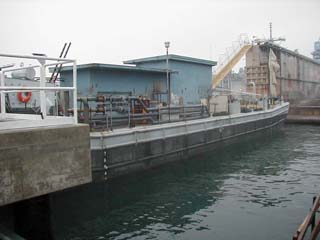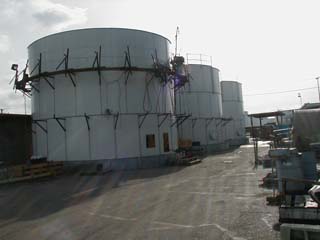
Surveys
DJC.COM
July 29, 2004
Todd Pacific halts a dirty waterfront legacy
Special to the Journal

Photos courtesy KPFF
Todd has a dedicated barge for collecting and treating drydock wash water.
|
Waterfront industrial sites throughout the U.S. have inherited a legacy of environmental degradation, stemming from decades of operation prior to the regulation of pollution.
In the new regulatory era of the 21st century, however, some waterfront industrial businesses are working to reverse this legacy by exceeding regulatory requirements. One such business is Todd Pacific Shipyards Corp. on Seattle's Harbor Island.
In operation since 1916, Todd is now one of the largest private ship repair and construction facilities in the Pacific Northwest. Todd's work includes new construction, repair, maintenance, and refurbishment of ships operated by the U.S. military and other government agencies, fishing fleets, cargo shippers, Washington State Ferries and cruise lines.
To stay competitive and meet increased regulatory requirements, Todd has developed a comprehensive approach for upland and in-water cleanup that is closely integrated with ongoing shipyard operations. Todd has also implemented numerous changes in the past decade that reflect a dedication to corporate environmental stewardship — from operational adjustments to facility infrastructure upgrades. These changes come with both costs and benefits.
Operational practices

Stormwater detention tanks were installed that can handle 10-year flow capacities, about 450,000 gallons.
|
Changes in day-to-day operations at Todd are reflected in the development and use of new best management practices (BMPs) to keep the facility clean and organized; improve hazardous waste handling and spill prevention programs; implement a comprehensive management program to prevent unused and spent sandblast grit from contacting storm and surface waters; use of high-pressure water-blasting as an alternative to sandblast grit; and use of less toxic substances, such as reduced VOC paint, in all areas of production.
Many of these environmental improvements create additional benefits: streamlining material handling in shipyard production, and providing concurrent safety and business improvements. Employees are trained in BMPs, pollution prevention measures and stormwater issues.
Cleaning up old contamination
Todd is responsible for cleaning up the historic contamination in sediments located offshore of its facility under the federal Superfund program.
The U.S. Environmental Protection Agency is overseeing cleanup activities throughout Harbor Island and the Duwamish River. Planning and design for the remedial work at Todd has been conducted by Floyd Snider McCarthy with assistance from KPFF Consulting Engineers' Special Projects Division.
The sediment remediation work, which includes dredging, capping, habitat mitigation and reconstruction of several shoreline structures, began in July. Todd contracted with General Construction for this work, which was designed to achieve significant environmental benefit while minimizing impacts to Todd's operations.
Industrial stormwater collection, treatment
As with all sediment cleanup projects, before the sediments can be remediated, control of upland pollution sources must be achieved. Historically, one of the primary sources of sediment pollution at Todd has been stormwater runoff from the shipyard.
Throughout Todd's history, rainfall that collected on facility pavements drained to catch basins and discharged to surface waters via outfalls. In the early 1990s, stormwater discharges became regulated under the National Pollutant Discharge Elimination System (NPDES), a federally-mandated and state-implemented permit program.
It was determined that the most effective and reliable system for meeting regulatory requirements would be collecting stormwater from the primary industrial yard pavements and discharging it to the sanitary sewer for eventual treatment at King County's treatment plant.
Floyd Snider McCarthy and KPFF conducted the planning, design and regulatory negotiations for Todd's industrial stormwater collection and treatment system, closely coordinating with Todd's engineering and facilities departments. The resulting system required an infrastructure investment of approximately $3 million, but now exceeds current regulatory requirements and eliminates all routine industrial stormwater discharges to receiving waters.
Todd's unique industrial stormwater collection and treatment system includes:
- Separation of roof and employee parking lot stormwater from contaminated stormwater, as required by wastewater treatment plant rules. The 1.4 acres of buildings required gutters, downspouts and underground piping to allow this clean water to discharge out existing outfalls.
- Collection and conveyance of more than 10 acres of industrial yard pavement runoff to on-site detention. That includes first-stage solids removal at catch basin sumps and second-stage solids removal and oil and grease separation using in-line settlement/treatment vaults. Water then enters four new on-site pump stations.
- On-site detention for a 10-year design storm storage volume of 450,000 gallons split between three new above-ground detention tanks, including third-stage solids removal in a detention tank sump.
- Controlled and metered discharge from the detention tanks to the city's sanitary sewer, meeting discharge flow limits set by the city.
- An emergency shutoff at the point of discharge to the city's sanitary sewer in the event of an off-site sewer system emergency requiring discharge control in coordination with the city.
The new industrial stormwater collection and treatment system demonstrates Todd's commitment to environmentally sound operations. The system is comprised of two large on-site drainage basins encompassing approximately 4.8 acres, the portion of the shipyard where most industrial activity occurs. Todd also chose to collect and route stormwater discharges associated with industrial activities on an additional 6.4 acres of industrial yard.
Todd designed and implemented upgrades to its dockwater pretreatment system. Dockwater originates from the drydocks and includes hydroblast and wash water, which carry a range of pollutants that cannot be discharged to surface waters. When it rains during drydock activities, wastewater volumes increase. Todd's upgraded dockwater system increased the total volume available for detention by using a compartmentalized floating barge, which is moored adjacent to the dry docks. This barge, named Compliance, houses all dockwater detention and pretreatment systems.
Construction activities
Todd recently finished a busy infrastructure construction effort. In order to prepare for planned sediment remediation activities that affect shoreline structures, main electrical systems needed to be redesigned and relocated, and several shoreline shop buildings required demolition.
Todd's NPDES permit required that the industrial stormwater system be operational by Dec. 31, 2003. With construction management support from Floyd Snider McCarthy and KPFF, Todd contracted with BMWC Constructors for a fast-track construction effort between September 2003 and January 2004 — during an intense period of shipyard operations, which included the drydocking of a U.S. Navy vessel that required heightened security throughout the yard.
Complicating construction was an unusually wet fall season, when more than 5 inches of rain fell in a 24-hour period. New construction work at Todd was also challenged by the maze of underground utility infrastructure established during the nearly 100 years of shipyard operations at the site.
Throughout the work, Todd maintained existing business operations, met customer needs and maintained a high level of scrutiny over contractor stormwater pollution prevention BMPs. The industrial stormwater collection and treatment system was operational at the end of December, only four months after the start of construction.
"This tremendous investment enables Todd to do two important things," says Todd CEO Steve Welch, "meet the needs of our customers through clean, efficient operations and operate as positive, environmentally-conscious stewards."
Don Oates is a professional civil engineer and principal of KPFF's Special Projects Division. Kate Snider is a professional civil engineer, landscape architect and principal of Floyd Snider McCarthy.
Other Stories:
- Conditional closures — another cleanup remedy
- Guy Battle: design and build to suit your climate
- Washington tests watershed management
- Going green? Try calling on your contractor
- Emerald City must fight to stay green
- Seattle prepares to ‘re-green' 2,500 acres
- Washington's new paint law gets the lead out
- Putting a price tag on nature
- South Lake Union: a model for sustainability
- Contractor finds silver at new headquarters
- Government finds gold at Sea-Tac Airport
- Quick Duwamish cleanup begins with teamwork
- 2004: A great year for the local environment
- Getting to compliance with a systems approach
- Don't let your site be taken to the cleaners
- Salmon get a boost from technology
- Low-impact development comes to Pierce County
- Energy Star label now ready for homes
- Improving traffic flow for fish, people
- Troubling times for Hood Canal's waters
- Utilities to study energy coming into homes
Copyright ©2009 Seattle Daily Journal and DJC.COM.
Comments? Questions? Contact us.